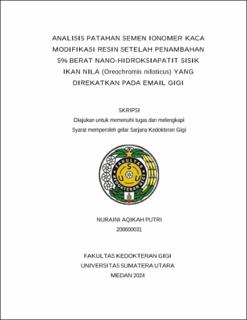Analisis Patahan Semen Ionomer Kaca Modifikasi Resin Setelah Penambahan 5% Berat Nano-Hidroksiapatit Sisik Ikan Nila (Oreochromis Niloticus) yang Direkatkan pada Email Gigi
Failure Analysis of Resin Modified Glass Ionomer Cement after Addition 5% Weight of Tilapia Scales (Oreochromis niloticus) to Enamel

Date
2024Author
Putri, Nuraini Aqikah
Advisor(s)
Harahap, Kholidina Imanda
Metadata
Show full item recordAbstract
Tensile bond strength as one of the mechanical properties of resin modified glass
ionomer cement needs to be considered in order to provide better adhesion with the
tooth surface. Several studies state that adhesion strength can increase if
hydroxyapatite is added. Hydroxyapatite can be synthesized from nature such as
tilapia fish scales (Oreochromis niloticus) and can be broken down into nanoparticles.
The aim of this research was to obtain the proportion and differences in fracture
categories of resin modified glass ionomer cement without the addition of nanohydroxyapatite
and with the addition of 5% by weight of nano-hydroxyapatite from
tilapia fish scales (Oreochromis niloticus) on tooth enamel. This research used tabletshaped
samples with a diameter of 4 mm and a height of 2 mm which had previously
been tested for tensile adhesive strength with two test groups, namely group 1 (without
the addition of nano-hydroxyapatite) and group 2 (addition of 5% by weight of nanohydroxyapatite).
The sample size for each group is 10 samples. After the tensile
adhesive strength test was carried out, the sample was soaked in distilled water
solution to keep it moist. Then, the fracture was observed using a Stereomicroscope
and Scanning Electron Microscope (SEM). The results of observations of restoration
material fractures on the tooth enamel surface were categorized into cohesive,
adhesive and mixed. Data were tested using the Chi-Square test (p<0.05). The results
of the fracture analysis in group 1 are in the mixed failure category for 8 samples,
cohesive failure for 1 sample, and adhesive failure for 1 sample. In group 2, namely mixed failure, 10 samples. It can be concluded that there is no significant difference
in fracture between groups 1 and 2. The best fracture occurs in group 2 which is
directly proportional to the previous tensile strength test value with a total of 10 mixed
fracture categories.
Collections
- Undergraduate Theses [1901]
